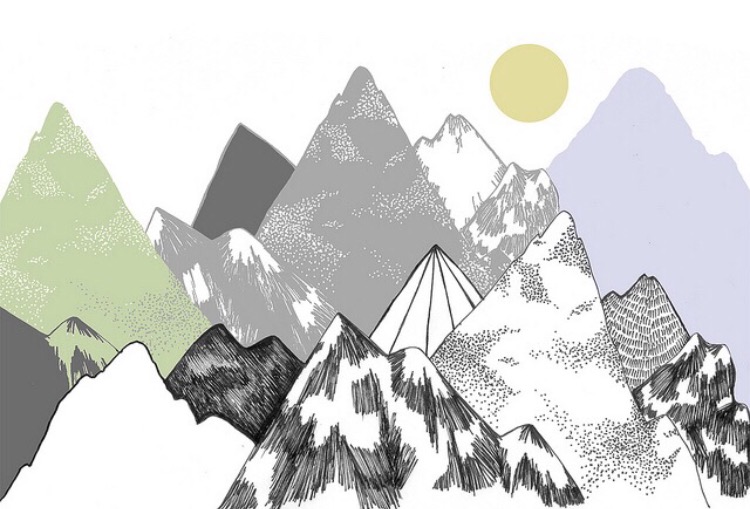The Things You Don't See in a Eating Disorder Recovery Hashtag
Editor's Note
If you live with an eating disorder, the following post could be potentially triggering. You can contact the Crisis Text Line by texting “NEDA” to 741741.
An Instagram snapshot of recovery: a still-very-prominently-thin girl holding a pint of Ben and Jerry’s ice cream, a tightly stretched smile with a hashtag-filled caption of #recoverypositivity, #eatittobeatit and #pintparties. The comments will be flooded with praise, well dones, even some subtle envy decoded in “I wish I could eat that.” If you are familiar with the Instagram recovery community, this is a fairly typical portrayal. You will also get the odd #transformationtuesday: on the left, an emaciated body check, on the right, a slightly less emaciated body check with a caption promoting Full Recovery and Full Weight Restoration. Everything is So Full, yet at the same time, everything is lacking. The detail: the reality of what recovering from an eating disorder is actually like, the raw portrayal of re-feeding and re-learning how to live again.
Nearly a decade in, recovery becomes less of a novelty and more of a necessity. The “honeymoon period” of rediscovering food, allowing yourself things that you have denied for months, going out for meals and buying A Whole New Wardrobe, soon wears off. When you are trying to pull yourself out of Yet Another Relapse, when you have pushed all your friends and family away, when you have no money to go out for meals or buy new clothes so succumb to the same baggy leggings day in day out – that’s when recovery begins to lose its appeal. And of course, anorexia is there, smirking because she-told-you-so-all-along. The biggest fears of ending up alone, abandoned, alienated – all seem to be becoming true. So you go back, tail between your legs, welcoming anorexia back like an old friend. The cycle is ceaseless: each time your body undergoes more stress, wastes away a little more, gets weaker with each relentless relapse. A disordered pattern of denying then devouring: taking its toll both mentally and physically.
The things that you don’t see in a Recovery hashtag: debilitating joint pain from deteriorating osteoporosis, a bloated stomach and fluid-filled ankles, painful mouth ulcers and dry, flaky skin. Agonizing pain from gallstones caused by excessive weight loss, chronic hunger that doesn’t shift, regardless of how much you eat. Bleeding gums, erratic blood pressure, an inability to regulate body temperature: the list is endless. Perhaps that’s why I find it so perplexing when anorexia is glamorized, trivialized even. Referring to it as the “slimmer’s disease” makes it sound like a cushy, celebrity diet with green juices and three personal training sessions a week. The concept of health doesn’t come into a starved mind, it takes a backseat along with the green juices and morning lemon water. The reality: you don’t want to get slim, you want to get sick.
Recovery is an ongoing, perpetual process. There is no benchmark where I can take my foot off the accelerator and have a break, without fear of anorexia creeping around the corner ready to drag me back down the same weathered path. Anorexia is not limited to the dinner table, it doesn’t dissipate as soon as lunchtime is over. The looming presence is there, as soon as you open your eyes to the minute you go to bed: even the respite of sleep is often interrupted with dreams of food and nightmares of failure. The notion that recovery automatically heals all is false – it is actually the time when you have to work the hardest, actively go against every ingrained thought that has been established up until this point. It feels alien, impossible, wrong. And yet, it is The Only Way Through.

The mountain analogy is overused and like many things associated with recovery, a cliché. Yet it is one I like to think back to in times of doubt. When you begin the long journey up the mountain path, you feel daunted but optimistic. You’ve prepared yourself for this, trained for months, had a million and one pep talks and now feel ready to take on the challenge. The first few miles are a breeze and you wonder what all the fuss was about. Sure, your legs ache a bit and you wouldn’t mind a rest but it’s not that bad, if anything it’s quite exciting being immersed in such beautiful scenery. As the sun begins to set, you start to feel slightly tentative, aware of how isolated you are and how much further you’ve got to go. You can’t see the top anymore; the incline is becoming steeper and you haven’t rested all day. Yet you carry on, terrified of being a failure or worse: letting other people down. The higher you get, the worse you feel. The altitude is sickening; you’re tired, weak, battered by the elements. All you want to do is turn back to the safety of flat ground and shelter. You reminisce over the shade of the mountain, protecting you from the sweltering sun and overwhelming noise from the birds and wind and rain. Yet you know that you must be getting closer, that if you push just-a-little-further you will reach the top and it will All Be Worth It. That’s what you’ve been told isn’t it? From professionals, friends, family. Yet deep down, you don’t believe it. Nothing compares to the safety of shelter, the haven away from life and emotion. So, you inevitably give up, scramble back down the mountain and for a few minutes, you feel safe again. Then reality dawns: you know one day, you have to climb the mountain. And when that day does come, you will have to do it all over again. The initial incline, the rocky terrain, the horrendous altitude. You have to get past all of that, for the second, third, tenth time and then find the strength to continue to the top.
When recovery feels impossible, when anorexia convinces you that Things Were Better when you couldn’t feel, couldn’t let the world touch you, remind yourself that this is only sustainable for so long. The shelter is temporary and the longer you stay, the more treacherous the mountain becomes. Stay put: cling onto the cliff face and cry for help. Remind yourself that it is OK to show emotion, that emotion doesn’t make you “weak.” Hold onto the precious moments: use them to get you through the next couple miles. And when you do eventually reach the top, when you can look over the edge and say You’ve Finally Made It, don’t look back with sadness at the years wasted and times attempted, be proud that despite everything, you persisted. You are resilient.
Mountains or metaphors, pint parties or peripheries: the premise is the same. Recovery is hard. It isn’t linear, there is no manual or prototype to the perfect path. It is messy, frustrating and at times, seems more hassle than it’s worth. But then you think of the alternative: more years wasted, more memories lost, continually living under a fabricated shelter that has never, and will never, make you happy. Anorexia propels the illogical into logic, crowns achievement in deception, praise in unreason. Above all, it discards fear, hesitation, empathy. Recovery proposes the opposite: to recognize value in people rather than percentages. To pick meals based on preference rather than numbers. To laugh, cry, feel. To learn and to grow. To venture down a new path, to feel the sun and not retreat into the shade.
Getty Image by noipornpan

